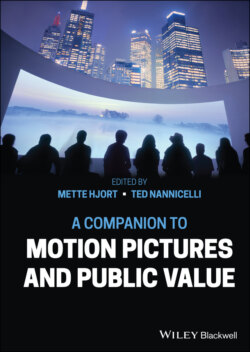Читать книгу A Companion to Motion Pictures and Public Value - Группа авторов - Страница 49
Appreciative Aptness, Film, and Generative Mediation
ОглавлениеThe most obvious way to understand what makes a representation appreciatively apt, implicit in our discussion to this point, is in terms of its allowing us to experience properties of its subject in roughly the way we would when directly experiencing it. For instance, a recording of a vocal performance seems appreciatively apt insofar as it allows us to experience heard qualities approximating those of the original performance (pitch, volume, and so on). Call this the experiential accuracy account of appreciative aptness. Another way to put it is that representations are appreciatively apt insofar as they are documentary, providing an experience of the object that mirrors the way a hypothetical perceiver would directly experience it.
But while intuitive, this account is too narrow. For a representation may be appreciatively apt, not because it accurately captures our direct perceptual experience of a natural object, but rather because it creates a new way in which we can experience properties of that object, and so appreciate it. Rather than being merely documentary of our experience of nature, it can also be generative of experiences of nature that we could not otherwise have.
This is evident in photography, which, as many have pointed out, allows us to experience natural events in an unnaturally static way. Rudolf Arnheim observed that in photographs “the rapid course of events is found to contain hidden moments which, when isolated and fixed, reveal new and different meanings.”18 Photography offers us the “isolated fixed instant” that we never experience in normal perception, and which opens up for us new possibilities for aesthetic appreciation. But once again, it is the cinematic techniques of nature film that provide the best examples of generative mediation.
Time-lapse cinematography allows us to experience the unfolding of events that are too slow for humans to perceive continuously. These techniques have been exploited since the first days of nature film, the 1910 silent film Birth of a Flower being an early example (Figure 3.2). High-speed cameras also allow for the perception of events too fast for us to perceive. These techniques also date to the earliest days of moving pictures, but have continued to be refined and improved so as to reveal previously hidden natural events. Today they are used scientifically, as in recent studies of the chameleon’s tongue strike during feeding, and also to aesthetic effect in nature film (high-speed digital footage of the chameleon strike was a highlight of the 2011 BBC documentary One Life; Figure 3.3).19
Figure 3.2 An image from The Birth of a Flower (Percy Smith, 1910).
Figure 3.3 The chameleon’s tongue from One Life (BBC Earth, 2011).
The mediated experience of nature offered by film, then, is more than a mere “stand in” for direct experience of nature; it is, itself, a rich source of aesthetic experience of nature. But despite our intimate familiarity with the medium of film, there is a stubbornly persistent tendency to think that the ideal for nature representation is merely to recapitulate direct human perception, and that departing from this ideal of experiential accuracy is a kind of failure. Even the esteemed nature film commentator David Attenborough, for instance, once remarked: “There is precious little that is natural…in any film. You distort speed if you want to show things like plants growing, or look in detail at the way an animal moves….You distort size by using close-up lenses…” (Burgess and Unwin 1984, 103). The confusion here is between allowing perception of a natural thing and reproducing natural perception: the former does not entail the latter. The only distortion that could be said to be inherent in varying film speed and magnification would be a distortion of unaided human perception. But properly regarded, this is not a “distortion” at all, but rather an expansion and enrichment of our ability to experience the natural world.20
